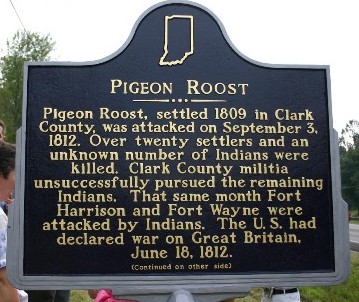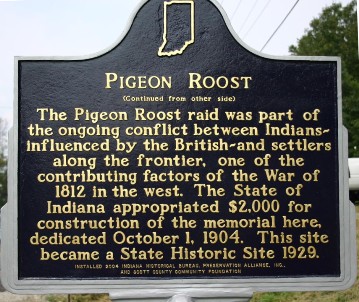

Location: Entrance to Pigeon Roost State Historic Site, US 31 and Edrington Blvd., 5 miles south of Scottsburg. (Scott County, Indiana)
Installed: 2004 Indiana Historical Bureau, Preservation Alliance, Inc., and Scott County Community Foundation
ID# : 72.2004.1
See also marker 72.2001.2 John Kimberlin Farm.
Text
Side one:
Pigeon Roost, settled 1809 in Clark County, was attacked on September 3, 1812. Over twenty settlers and an unknown number of Indians were killed. Clark County militia unsuccessfully pursued the remaining Indians. That same month Fort Harrison and Fort Wayne were attacked by Indians. The U.S. had declared war on Great Britain, June 18, 1812.
Side two:
The Pigeon Roost raid was part of the ongoing conflict between Indians—influenced by the British—and settlers along the frontier, one of the contributing factors of the War of 1812 in the west. The State of Indiana appropriated $2, 000 for construction of the memorial here, dedicated October 1, 1904. This site became a State Historic Site 1929.
Keywords
American Indian/Native American, Military
Annotated Text
Pigeon Roost, settled 1809 in Clark County, (1) was attacked on September 3, 1812. Over twenty settlers(2) and an unknown number of Indians were killed.(3) Clark County militia unsuccessfully pursued the remaining Indians.(4) That same month Fort Harrison and Fort Wayne were attacked by Indians.(5) The U.S. had declared war on Great Britain, June 18, 1812.(6)
The Pigeon Roost raid was part of the ongoing conflict between Indians-influenced by the British-and settlers along the frontier, one of the contributing factors of the War of 1812 in the west.(7) The State of Indiana appropriated $2, 000 for construction of the memorial here, dedicated October 1, 1904.(8) This site became a State Historic Site 1929.(9)
Notes:
(1)Carl R. Bogardus, The Pigeon Roost Massacre (Austin, Ind., 1962), 5; Col. William M. Cockrum, Pioneer History of Indiana (Oakland City, Ind., 1907), 354; John B. Dillon, A History of Indiana (Indianapolis, 1859), 492. Pigeon Roost was settled because of fertile land enriched by pigeon droppings. Bogardus, 5; George Knight Hester, "Narratives of the Reverend George Knight and His Wife, Benee (Briggs) Hester, " Indiana Magazine of History, vol. 22 (June 1926), 147. Clark County was formed February 3, 1801. George Pence and Nellie C. Armstrong, Indiana Boundaries (Indianapolis, 1967), 256. Scott County was formed in 1820. Ibid., 730.
(2)John D. Barnhart and Dorothy L. Riker, Indiana to 1816: The Colonial Period (Indianapolis, 1971), 401; John Gibson to Colonel William Hargrove, September 8, 1812, in Cockrum, 359-60. There are many accounts of this tragedy in which the actions and specific numbers killed vary. Copies of all located are available in the file for this marker at the Indiana Historical Bureau.
(3)"It was supposed that Mr. Collins had killed one or two of them." Hester, 151. "The Massacre at Pigeon Roost, " New Albany Daily Ledger, January 19, 1853. Accounts vary about how many Indians were killed.
(4)Dillion, 493; Logan Esarey, A History of Indiana (Fort Wayne, Ind., 1924), 219.
(5)On September 4, Indians set fire to one of blockhouses at Fort Harrison in what is now Vigo County. Barnhart and Riker, 401. September 5-11 Indians attacked Fort Wayne, but were repulsed. Barnhart and Riker, 402. On September 8, Gibson ordered Hargrove to have settlers prepare forts if they were unprotected or move families to protection. Gibson to Hargrove, in Cockrum, 359-60. On September 12, Gibson ordered Hargrove to make the settlers go to where there was protection. Gibson to Hargrove, in Cockrum, 360.
(6)Barnhart and Riker, 398. The majority of Indians sided with the British. Ibid., 397, 401.
(7)For example, in April 1812, Indians had killed a family of seven near Vincennes; settlers fled for protection. William Henry Harrison to Secretary of War, April 22, 29, 1812, in Logan Esarey, ed., Governors Messages and Letters (Indianapolis, 1922), 41, 42. Barnhart and Riker, 399, indicate that "The renewal of Indian warfare in Indiana and Illinois territories also affected the decision of some western Congressmen to declare war, though the delegates of these territories could not vote." A Memorial, "Defense of the Territory, 1813, " was sent on March 11, 1813 to President Madison. The Laws of Indiana Territory, 1809-1816 (Indianapolis, 1934), 793-95.
The Treaty of Ghent, December 24, 1814, ended war with England. Barnhart and Riker, 409. "For the West, the significance of the war lies in the defeat of the Indians which removed the last barrier to frontier expansion and in the rise of American nationalism, which brought a new interest in the West." Barnhart and Riker, 411.
(8)Laws of Indiana 1903, Chapter 14, 25-26; Indianapolis News, October 1, 1904; Indianapolis Sunday Sentinel, October 2, 1904.
(9)"Pigeon Roost State Historic Site, " (accessed November 5, 2001)
